Cluster M 16 with Eagle Nebula IC 4703
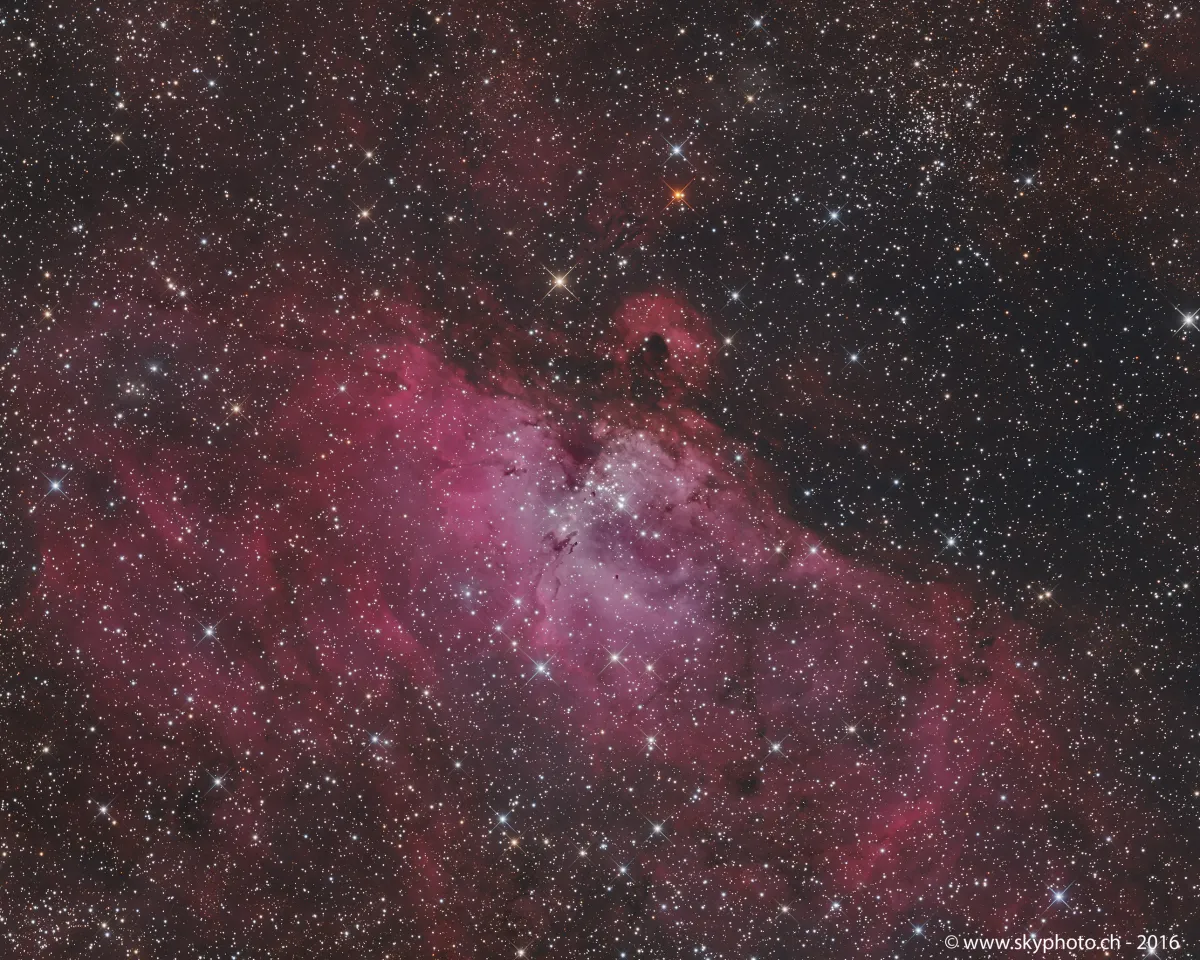
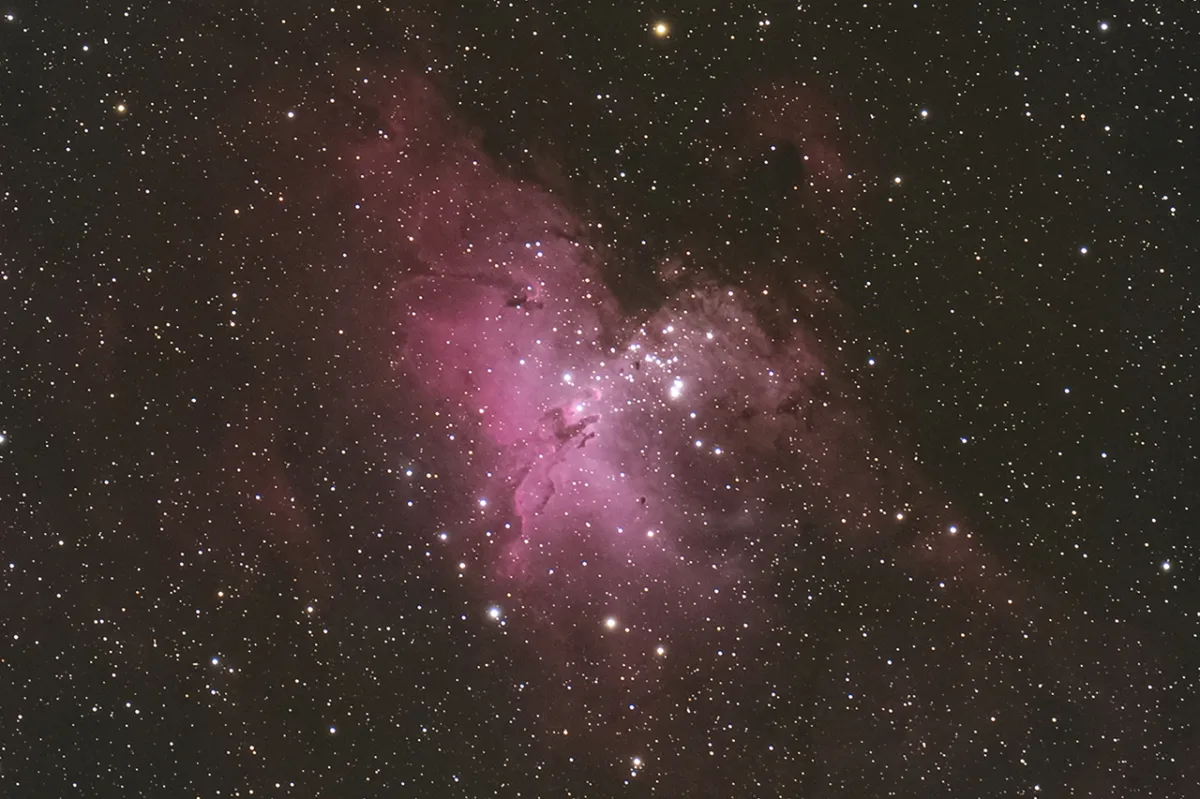
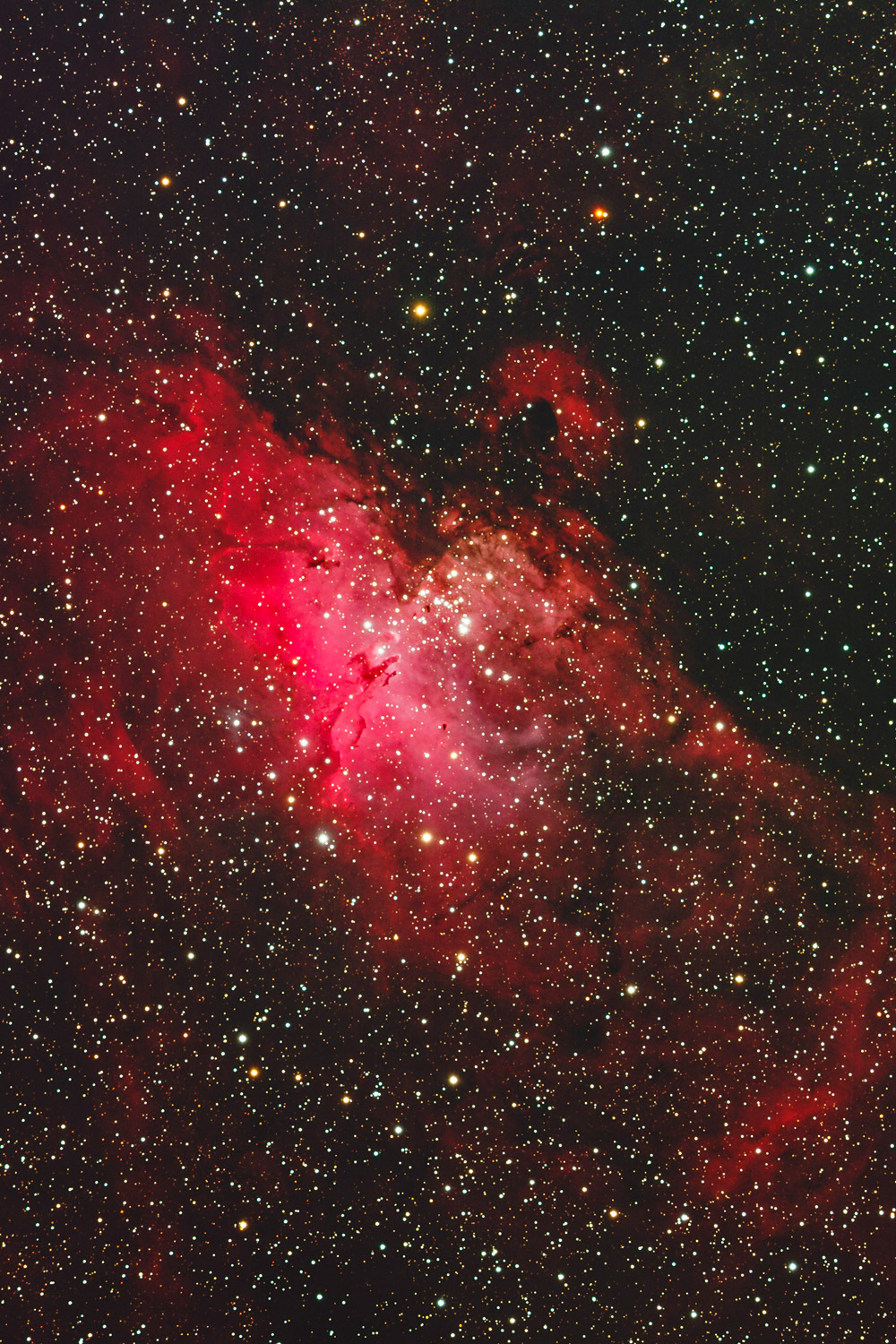
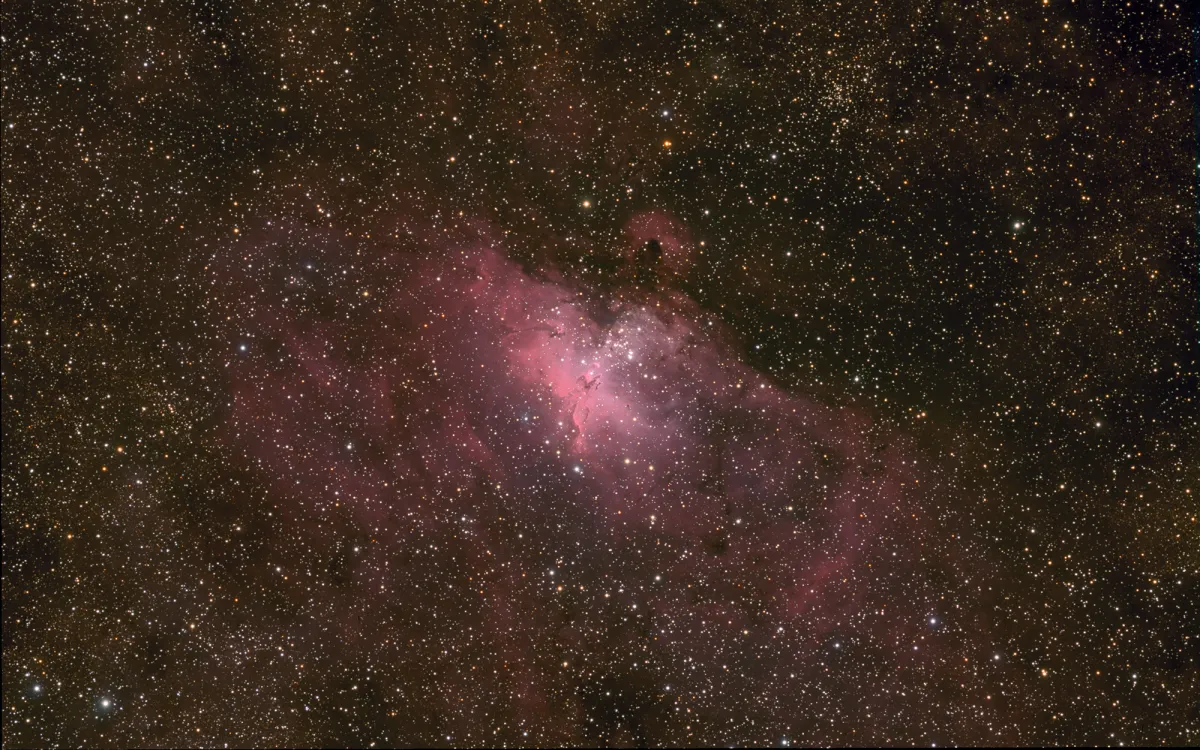
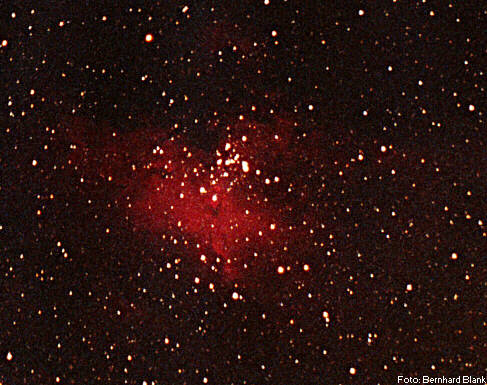
History
Presumably the open star cluster Messier 16 was discovered first by the Swiss astronomer P. L. de Cheseaux in 1746. 18 years later, Charles Messier came across the same star cluster and was one of the first to recognize that M 16 is embedded in a faint nebula. In this case, however, this was more a coincidence and was due to the poor contrast performance of the telescopes used, because Messier also saw non-existent, diffuse nebulae in other star clusters. In addition, numerous astronomers later and at the same time, including John Herschel, did not yet recognize a nebula at M 16. John C. Duncan discovered the nebula in the 12 inch refractor of the Within Observatory and classified it as more easily recognizable than the nebula in the Pleiades EE Barnard was possibly the first to take a picture of M 16 with the nebula in 1895. The nebula was then included in his second Index Catalogue by John LE Dreyer under the designation IC 4703.
The romantic name Star-Queen Nebula comes from Robert Burnham after the dark silhouette in the middle of the nebula, which gives the impression of a queen sitting on a throne. He found the name Eagle Nebula is a bit too prosaic for such an object, and the eagle has already been immortalized in two bright first-class stars, Vega and Atair. [4]
In most atlases and catalogs, the open star cluster and the surrounding nebula can be found under the designation M 16. In the Uranometria 2000.0, however, a distinction is made between the cluster M 16 (NGC 6611) and the nebula IC 4703.
Physical Properties
The open star cluster M 16, surrounded by the nebula, is mainly located in the northwestern part of the nebula and contains a large number of giants of the O and B types, stars of great luminosity and high temperature. Numerous short-lived blue giants are present and many weak T-Tauri-type variables believed to be still in the process of gravitational contraction. It is believed that the cluster is only about 800'000 years old and some of the stars only began to shine about 50'000 years ago. In other sources one finds an age of 55 million years - also very young from a cosmic point of view.
Because of the strong and very different darkening and reddening of the stars by the nebula, sometimes up to four magnitudes, it is difficult to determine the exact distance of the star cluster. Estimates range from 4'200 to 11'000 light years, the last and best being around 7'000 light years. It puts M 16 in the large Sagittarius spiral arm of our galaxy, which also agrees well with the radio measurements. [4]
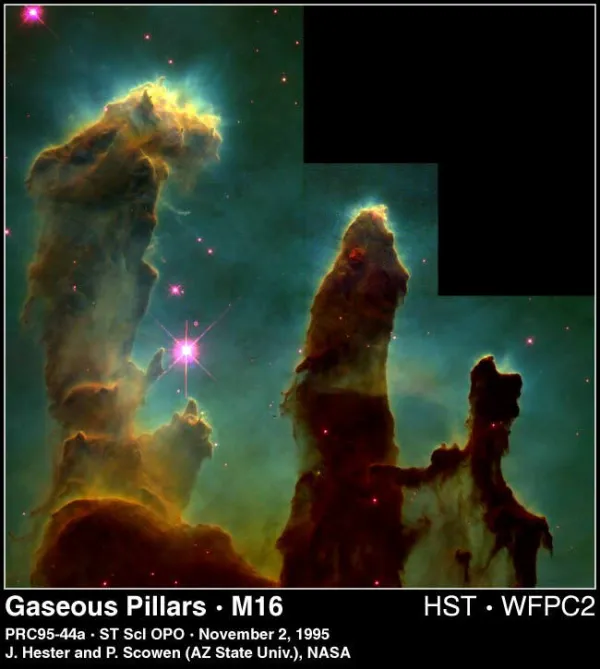
The three-fold false colour composite of the Hubble Space Telescope shows a section of the Eagle Nebula IC 4703. The blue colour represents the emission light from doubly ionized oxygen at 500.7 nm, green that of hydrogen-alpha at 656.3 nm and red that of singly ionized sulfur at 672.5 nm.
The central region of the nebula marks the boundary between a glowing H-II region and dark molecular clouds. It is believed that this is the ideal place for photo evaporation - a process in which UV radiation from hot, young stars slowly erodes an adjacent cloud, which Fred Hoyle called the Elephant's Trunk, it is the head of the molecular cloud in the H-II region. This has held up better in the strong, ionizing radiation than less dense clouds in the area, which have been ionized and dispersed long before. These proboscis may also be eroded.
The HST image clearly shows how gas flows off from the part of the cloud illuminated by the star cluster. At the upper end of the left pillar, a few small finger-like protrusions can be seen, closed by EGGs (Evaporating Gaseous Globules) at their tip. In these EGGs, which are slightly larger than our solar system, there are stars and possibly also planets in a very early stage of development. These globules shield the gas behind them from the strong radiation of the star cluster and thus create this finger structure. Such EGGs can be observed at different stages of development throughout the nebula. A nascent star can even be observed in some. Our solar system may have looked something similar more than six billion years ago. [174]
Radio emissions from the Eagle Nebula were first detected using the 300 feet dish at the National Radio Astronomy Observatory of Green Bank, West Virginia. In a later study it was found that nebulae and star clusters are around 12,500 solar masses. At the accepted distance, the diameter of the nebula is around 70 light years.
| Name | RA | Dec | Type | vMag | Dim | MD | Dreyer Description | Identification, Remarks |
|---|---|---|---|---|---|---|---|---|
| NGC 6611 | 18 18 45.0 | -13 47 54 | OCL (II3mn) | 6.0 | 8 | 1.719 | Cl, at least 100 st L & S | h 2006; GC 4400; M 16; OCL 54; Eagle Nebula embedded |
| IC 4703 | 18 18 00.0 | -13 50 00 | EN | 35 × 28 | 2.100 | B, eL, Cl M. 16 inv | LBN 67; Eagle Nebula (in M 16) |
How do you find the Eagle with the Star Queen?
The Eagle Nebula M 16 is located near the «triangle» of Serpentis Cauda, Scutum and Sagittarius, only 3 degrees north of the Swan Nebula (M 17) in Sagittarius. With the help of the adjacent map and a large field eyepiece, it is easy to adjust this gem in the telescope. The star cluster can be seen with the naked eye on a dark night. The best observation time is February to December.
Visual Observation
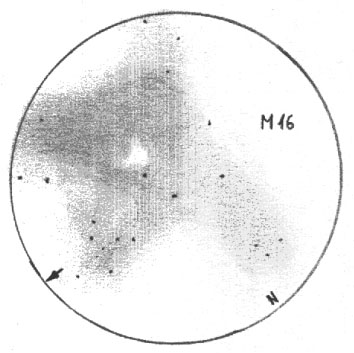
350 mm Aperture: The pronounced eagle shape can already be seen in smaller telescopes with low magnification and a large field of view. The two dark fingers call for an alpine sky and medium-sized amateur telescopes in order to be safely perceived. — 14" PWO-Dobson, F:4.6 / TV-Radian 8mm, 200x, 0.3°, Eduard von Bergen
400 mm Aperture: In the open star cluster M 16, IC 4703 is easily recognisable as a nebula in the 21 mm Ethos eyepiece even without a filter. With an O-III filter, the nebula stands out clearly from the background. It looks more like a sliced mushroom than an eagle. In the 13 mm Ethos, the nebula appears to fill the image and dark structures can be seen inside. — 400 mm f/4.5 Taurus Dobsonian, Ahornalp, SQM 21.2, 30. 5. 2025, Bernd Nies
